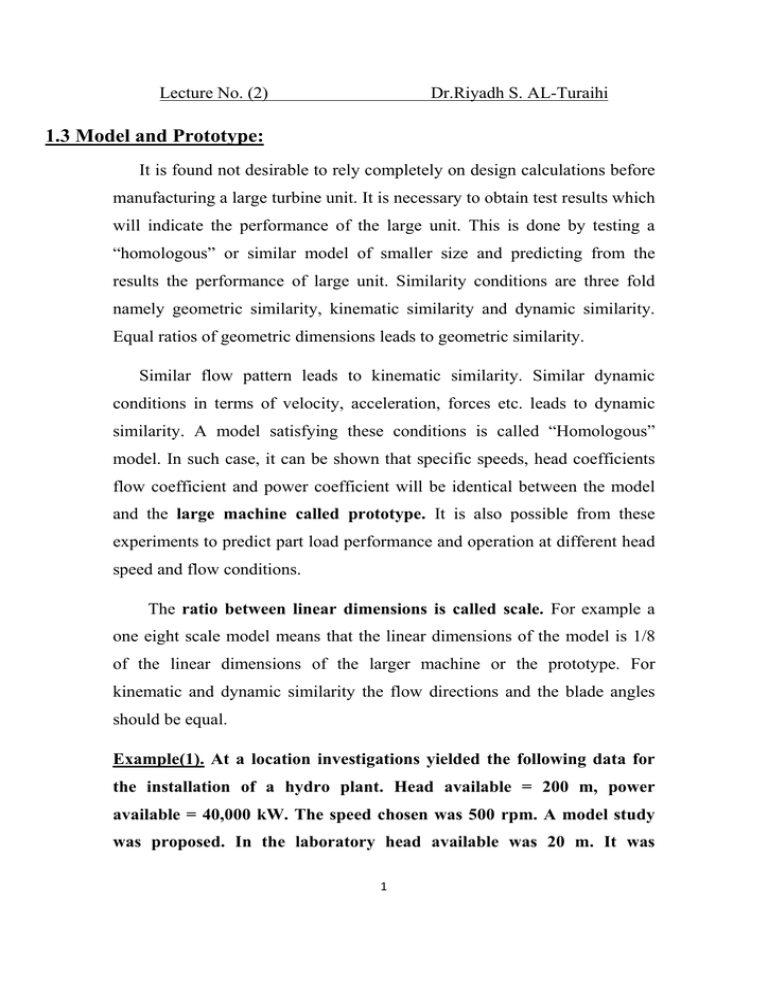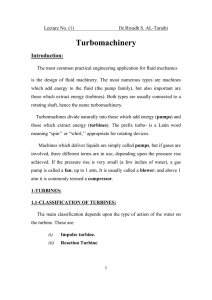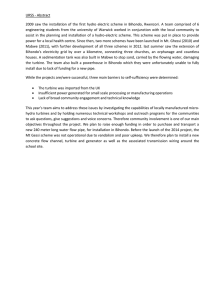1.3 Model and Prototype:
advertisement

Lecture No. (2) Dr.Riyadh S. AL-Turaihi 1.3 Model and Prototype: It is found not desirable to rely completely on design calculations before manufacturing a large turbine unit. It is necessary to obtain test results which will indicate the performance of the large unit. This is done by testing a “homologous” or similar model of smaller size and predicting from the results the performance of large unit. Similarity conditions are three fold namely geometric similarity, kinematic similarity and dynamic similarity. Equal ratios of geometric dimensions leads to geometric similarity. Similar flow pattern leads to kinematic similarity. Similar dynamic conditions in terms of velocity, acceleration, forces etc. leads to dynamic similarity. A model satisfying these conditions is called “Homologous” model. In such case, it can be shown that specific speeds, head coefficients flow coefficient and power coefficient will be identical between the model and the large machine called prototype. It is also possible from these experiments to predict part load performance and operation at different head speed and flow conditions. The ratio between linear dimensions is called scale. For example a one eight scale model means that the linear dimensions of the model is 1/8 of the linear dimensions of the larger machine or the prototype. For kinematic and dynamic similarity the flow directions and the blade angles should be equal. Example(1). At a location investigations yielded the following data for the installation of a hydro plant. Head available = 200 m, power available = 40,000 kW. The speed chosen was 500 rpm. A model study was proposed. In the laboratory head available was 20 m. It was 1 Lecture No. (2) Dr.Riyadh S. AL-Turaihi proposed to construct a 1/6 scale model. Determine the speed and dynamo meter capacity to test the model. Also determine the flow rate required in terms of the prototype flow rate. Example (2) In example (1) the data in the proposed plant is given. These are 200 m, head, 40000 kW power and 500 rpm. A one sixth scale model is proposed. The test facility has a limited dynamometer capacity of 40 kW only whereas the speed and head have no limitations. Determine the speed and head required for the model. Example (3). Use the data for the proposed hydro plant given in example (1). The test facility has only a constant speed dynamometer running at 1000 rpm. In this case determine power of the model and the test head required. 1-4 Unit Quantities: The dimensionless constants can also be used to predict the performance of a given machine under different operating conditions. As the linear dimension will be the same, the same will not be taken into account in the calculation. Thus Head coefficient will now be: The head will vary as the square of the speed. The flow coefficient will lead to 2 Lecture No. (2) Dr.Riyadh S. AL-Turaihi Flow will be proportional to N and using the previous relation The constant is called unit discharge. Similarly This constant is called unit speed. Using the power coefficient: Or Hence when H is varied in a machine the other quantities can be predicted by the use of unit quantities. 3 Lecture No. (2) Dr.Riyadh S. AL-Turaihi Example(4): A turbine is operating with a head of 400 m and speed of 500 rpm and flow rate of 5 m3/s producing the power of 17.66 MW. The head available changed to 350 m. It no other corrective action was taken what would be the speed, flow and power? Assume efficiency is maintained. 1-5 TURBINE EFFICIENCIES: The head available for hydroelectric plant depends on the site conditions. Gross head is defined as the difference in level between the reservoir water level (called head race) and the level of water in the stream into which the water is let out (called tail race), both levels to be observed at the same time. During the conveyance of water there are losses involved. The difference between the gross head and head loss is called the net head or effective head. It can be measured by the difference in pressure between the turbine entry and tail race level. The following efficiencies are generally used. 1. Hydraulic efficiency: It is defined as the ratio of the power produced by the turbine runner and the power supplied by the water at the turbine inlet. Where Q is the volume flow rate and H is the net or effective head. Power produced by the runner is calculated by the Euler turbine equation . This reflects the runner design effectiveness. 4 Lecture No. (2) Dr.Riyadh S. AL-Turaihi 2. Volumetric efficiency: It is possible some water flows out through the clearance between the runner and casing without passing through the runner. Volumetric efficiency is defined as the ratio between the volume of water flowing through the runner and the total volume of water supplied to the turbine. Indicating Q as the volume flow and ∆Q as the volume of water passing out without flowing through the runner. To some extent this depends on manufacturing tolerances. 3. Mechanical efficiency: The power produced by the runner is always greater than the power available at the turbine shaft. This is due to mechanical losses at the bearings, windage losses and other frictional losses. 4. Overall efficiency: This is the ratio of power output at the shaft and power input by the water at the turbine inlet. Also the overall efficiency is the product of the other three efficiencies defined 5




